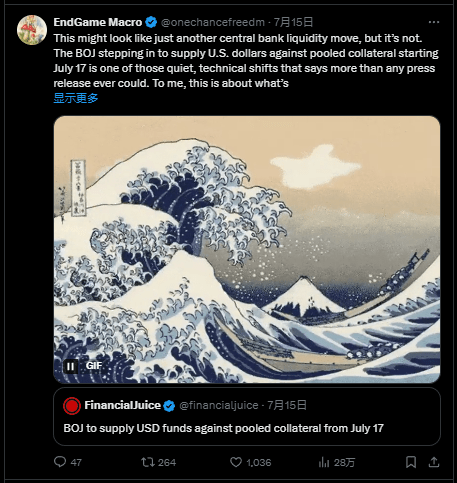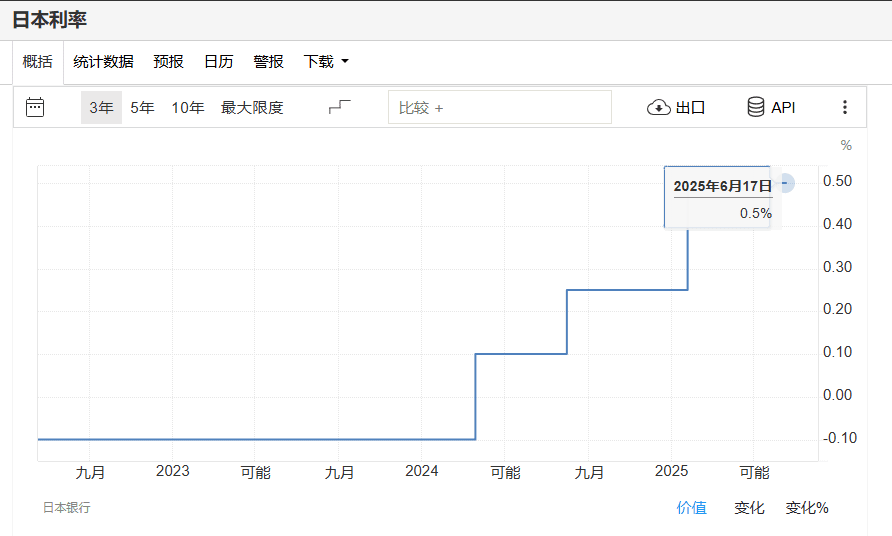The recent quietly initiated dollar liquidity supply measures by the Bank of Japan are attracting widespread attention to the deep pressures within the global financial system.
On July 15, the Bank of Japan announced that starting from July 17, it would provide dollar funds to the market in the form of pooled collateral. This seemingly routine liquidity management operation was interpreted by macro analyst EndGame Macro as potentially signaling that more severe systemic risks are brewing.

This analyst's viewpoint is based on the observation of increasing internal pressures within the global dollar financing ecosystem and the cumulative effects of Federal Reserve Chair Jerome Powell's continued hawkish policies.
Pressure on Japanese arbitrage trades and systemic stability
The deeper reason behind this move by the Bank of Japan lies in its response to the challenges faced by domestic financial institutions. These institutions have been accustomed to borrowing yen at low rates for years and converting them into dollars for investment.
However, as the Federal Reserve's interest rate hikes lead to rising dollar rates and the continued depreciation of the yen, this arbitrage strategy is becoming increasingly unsustainable. The Bank of Japan's intervention this time appears more as a preventive measure rather than a crisis response.
On a deeper level, the Bank of Japan's action reflects the harsh reality that global dollar liquidity is tightening. When a country's central bank has to intervene to provide dollar liquidity, it often means that private enterprises and individual investors find it difficult to effectively allocate and manage dollar funds.
Looking back at history, similar situations have occurred during the 2008 financial crisis, the 2011 European debt crisis, and even the market turbulence of 2019-2020. These precedents ultimately evolved into serious market fractures, forcing central banks worldwide to intervene urgently.
The impact of the Bank of Japan's interest rate hike on the risk asset market
The Bank of Japan's decision coincided with its interest rate hike to 0.5%, the highest level since 2008, while maintaining a negative interest rate of -0.1% from 2016 to early 2024. This interest rate hike has impacted both the Japanese and international markets, with Metaplanet's stock price also experiencing a significant drop.

It is worth noting that higher interest rates not only squeeze arbitrage trading space but also exacerbate global asset volatility, potentially triggering rapid capital withdrawals from high-risk assets such as cryptocurrencies.
As predicted by former BitMEX CEO Arthur Hayes, in a context of tightened global dollar supply and rising costs, high-risk assets such as Bitcoin often come under pressure, with prices of such assets potentially experiencing sudden surges or drops.
However, if central banks such as the Federal Reserve and the Bank of Japan take coordinated actions or expand liquidity supplies, such as through currency swap agreements or implementing new quantitative easing policies, high-risk assets like cryptocurrencies may experience significant price increases.
Conclusion:
In summary, the current policy choices of the Bank of Japan highlight the complexity of the situation. On one hand, it is curbing inflation through interest rate hikes to address a persistent inflation rate above 3%; on the other hand, it is actively providing dollar liquidity to alleviate pressure on the financial markets and prevent market turbulence caused by the unwinding of arbitrage trades. This policy combination reflects the difficult balance faced by the Japanese economy in a special predicament.
As analysts have pointed out, such seemingly 'silent' measures may often be a harbinger of significant changes. Therefore, market participants need to remain highly vigilant and closely monitor subsequent developments to assess whether this indicates a broader global liquidity crisis is quietly forming.


